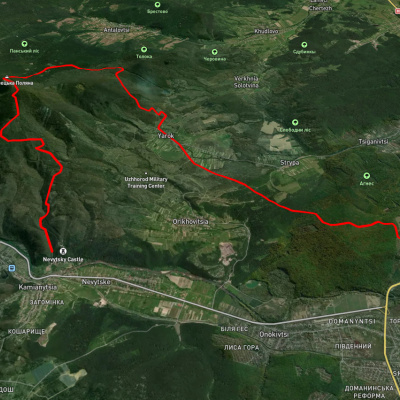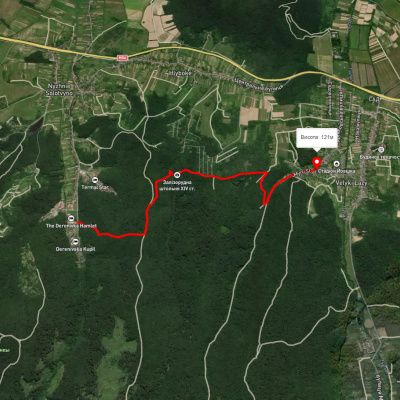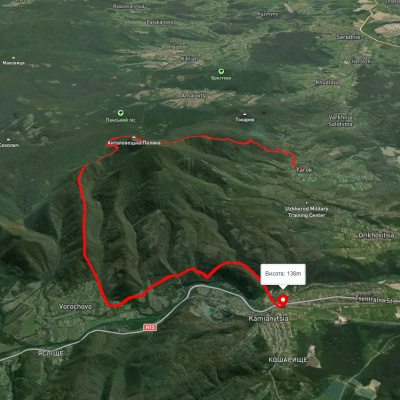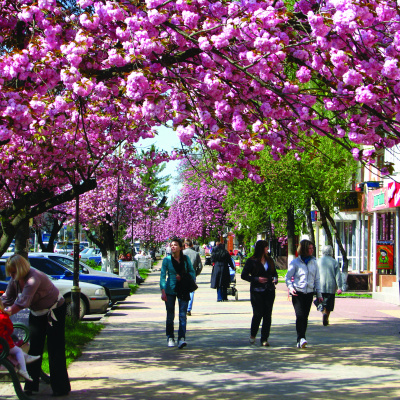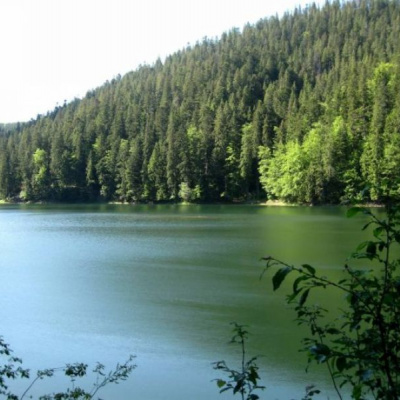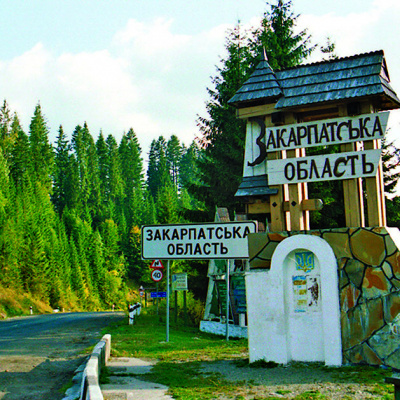Transcarpathian region
Zakarpattia region is located in southwestern Ukraine. It borders Lviv region to the north, Ivano-Frankivsk region to the east, Romania to the south, Hungary to the southwest, Slovakia to the west, and Poland to the northwest. The administrative center is the city of Uzhhorod. The ethnic composition is dominated by Ukrainians: in the northwest - ethnic groups of Boikos and Lemkos, in the east - Hutsuls. There are also Hungarians, Russians, Romanians, Slovaks, Germans, and Gypsies - more than 30 nationalities in total living in the following districts of the region: Uzhhorod, Berehovo, Velyky Berezny, Vynogradiv, Volovets, Irshava, Mizhhirya, Mukachevo, Perechyn, Rakhiv, Svalyava, Tyachiv, and Zakarpattia,
It is in any of these districts that you can book comfortable accommodation in the private or hotel sectors.
About 80% of the region's territory is occupied by mountains, forming the Watershed Range, Gorgany, Svydovets, Chornohora, Polonyna Range, Rakhiv Massif, and Volcanic Carpathians from southwest to southeast. On the Chornohora ridge is Mount Hoverla(2061 m), which is the highest point in the region and Ukraine. Transcarpathia is connected to other regions by the Yablunytsia, Vyshkiv, Uzhok, Veretsky, and Volovets passes with heights ranging from 931 to 1014 m. The southwestern part of the region is occupied by the Transcarpathian lowland (100-120 m).
There are 9429 rivers and streams in the region. The longest river is the Tisa (left tributary of the Danube). Its length within the region is 240 km. The largest tributaries are Borzhava, Rika, Tereblya, and Teresva. The next largest rivers, the Latorytsia and the Uzh, flow into the Bodroh River. There are 137 natural lakes in the region, mostly of glacial and general origin, the largest of which is Synevyr.
Mineral resources of the region: deposits of polymetals, allunites, perlites, zeolites, liparites, significant reserves of rock salt of Solotvyno deposit; kaolin is being extracted, 13 deposits of carbonate raw materials (marble limestone, dolomite, marble) have been discovered. More than 360 mineral water springs with different chemical composition and medicinal properties have been discovered and studied.
The geographical center of Europe is located in the Transcarpathian region near the village of Dilove in Rakhiv district, and the small town of Bene is famous for its fine wines and ancient wine cellars.
The climate in Zakarpattia is temperate continental, and the word "moderate" in this term is true. There is neither too much nor too little of everything: sun in summer, snow in winter, and in the off-season the weather tries not to make tricks in the form of lingering rains. On the plains, the air warms up more throughout the year than in the mountains. The average temperature in July is +20°C, and in January it is -4°C. In general, the climate is much warmer than in other parts of Ukraine at the same latitude.
The first mention of human life on the territory of Zakarpattia dates back to the Early Paleolithic period (ca. 1 million years BC). In the third century, under the pressure of the Romans, the Carpians, one of the Thracian tribes, moved here from the valleys of the Siret and Prut. According to many scholars, the Carpathians were named after this tribe.
The history of Zakarpattia is an integral part of the history of Ukraine, but it has a number of peculiarities that have affected the economic, political and ethnic development of the region. Occupying an important geographical position on the southern slopes of the Ukrainian Carpathians, Transcarpathia, which at different times was called "Hungarian Rus", "Carpathian Rus", "Subcarpathian Rus", "Transcarpathian Ukraine", was part of the Kingdom of Hungary, the Austrian Habsburg Monarchy, the Czechoslovak Republic, and Khortist Hungary until the mid-20th century. Because of this, Zakarpattia is a very distinctive region of Ukraine, with its own dialect, cuisine, and other local features.
Residents of other regions of Ukraine sometimes confuse Zakarpattia with Prykarpattia, believing that its population has somewhat radical nationalist views. The real picture is quite the opposite of this stereotype. Transcarpathians are famous for their hospitality and multiculturalism. Here you can hear Russian, Ukrainian, Hungarian, Romanian and other languages, which sometimes mix to form a colorful local dialect. And they will always try to find common ground with the guests of the region, switching to their language (from what we heard from the staff of one of the sanatoriums: "We'll learn any language, just let foreigners come to us").
The following architectural and natural monuments, castles, and museums are worth visiting:
- Boyko churches in Velykyi Bereznyi district;
- Wine cellars in the village of Serednye, Uzhhorod district;
- Templar Castle in Serednye village, Uzhhorod district;
- Nevytskyi Castle in the village of Kamianytsia, Uzhhorod district;
- Horyany Rotunda in Uzhhorod;
- Gothic Potyssia - churches in Berehove, Vynohradiv, Rakhiv, Tyachiv, and Khust districts;
- St. Martin's Chapel in Mukachevo;
- Palanok Castle in Mukachevo;
- Mukachevo Historical Museum in Mukachevo;
- St. Miklos Castle in the village of Chynadiyovo, Mukachevo district;
- Lemko churches: St. Nicholas (Svaliava) and St. Michael's (Uzhhorod, Museum of Folk Architecture and Life);
- Schönborn Palace in the village of Karpaty;
- Golden Pava Restaurant in Berehove;
- Museum of Beregovo district
- Kvasivskyi, Kvasovo village, Berehove district
- Baron Pereni's estate in Vynohradiv;
- "Kankiv", Vynogradiv;
- "Nyalab, Korolevo, Vynohradiv district;
- Synagogue in Uzhhorod;
- Uzhhorod Castle in Uzhhorod;
- Dovhe Castle in the village of Dovhe, Irshava district;
- Hamora Smithy Museum in the village of Lysychovo, Irshava district;
- Khust Castle in Khust;
- Transcarpathian Museum of Local Lore;
- Transcarpathian Museum of Folk Architecture and Life;
- Zatsytsia Museum of Local Lore;
- "Lemkivska manor";
- "Sriberna land";
- "Old school";
- "Old Village";
- Voevodyno waterfall in Perechyn district;
- Valley of daffodils in Khust;
- Enchanted Valley;
- Lake Brebeneskul;
- Lake Synevyr;
- Pearl cave;
- Cave of transparent walls;
- Polonyna Dragobrat;
- Polonyna Runa (Rivne);
- Salt lakes;
- Yalyn waterfall;
- Shypit waterfall in the village of Pylypets;
- Likhyi waterfall;
- Skakalo waterfall in the village of Chynadiyevo;
- Trufanets;
- Vyshovatsky waterfalls;
- Gorodilovsky waterfall;
- Dragobrat waterfall;
- Kamianets waterfall;
- Kobyletsky Hook;
- Lumshory waterfalls: Solovey, Burkach, Davir (Partizan), Perestupen, Krutylo;
- Nires waterfall;
- Plishka waterfall;
- Yuntur (near Voyevodyn);
- Bilyi Waterfall (near Yalyn Waterfall);
- Hanychi Waterfall (on the left tributary of the Teresva River, near the village of Hanychi).
Interesting facts:
- The highest mountainous city is Rakhiv. Its average height is 820 m. This city holds another record - the largest height difference between streets is 600 m: from the lowest (400 m) to the highest (1000 m).
- The deepest hospital is located in the village of Solotvyno, where the microclimate of salt mines has been used since 1968 to treat patients with bronchial asthma.
- The tallest structure is a five-meter stele erected in 1996 on Hoverla Mountain, where the state symbols - the blue and yellow flag and trident - are placed.
- The longest tunnel is a railroad tunnel on the Skotarske-Beskyd stretch, 1747 meters long, built in 1887.
- The longest viaduct is a railway bridge on the Volovets-Beskyd section, built in the mid-1980s, 33 m high and 270 m long.
- The highest sports facility is the Dragobrat ski base on the mountain meadow of the same name (1450 m) near the village of Yasinya. The uniqueness of this place is in the abundance of snow. Every year the ski season here begins in December and ends in May.
- The highest mountain lake is Brebeneskul, located on the slopes of the Gutyn-Tomnatyk and Brebeneskul mountains at an altitude of 1801 m; its area is 4 km2, maximum depth - 2.8 m.
- The largest mountain lake is Synevyr in Mizhhirya district. The area is 7 hectares and the depth is up to 24 meters. It is popularly called "Blue Eye", "Sea Eye", "Carpathian Ritsa". A strong earthquake, or perhaps centuries of weathering, caused the rocks to collapse, damming up the valley of a mountain stream and forming a lake at an altitude of 989 m.
- The Narcissus Valley, near the town of Khust, is the only plain place in Ukraine where snow-white narrow-leaved daffodils grow naturally. They look very similar to garden daffodils, but the flowers are larger and sometimes reach 10 cm in diameter.
- Near the village of Mala Uholka in the Tyachiv district, in the river valley, there is an unusual rock called the Stone Gate, which is a kind of karst bridge in the marbleized limestone of the Jurassic period, where karst processes have made a passage 10 m wide and 3 m high.
- The European larch in Rakhiv can be considered the record holder among trees in terms of height. When it was cut down at the age of 140, it was 54 meters high.
- Zakarpattia offers many opportunities for recreation: skiing in winter and hiking in summer, but all seasons are suitable for mineral or thermal water treatment, sightseeing, wine and cognac tasting, and horseback riding. The only caveat is that it is difficult to find a place to stay during the New Year and Christmas holidays.
Які туристичні (пішохідні) маршрути проходять через/біля Transcarpathian region?
Пропонуємо пройти такі туристичні (пішохідні) маршрути через/біля Transcarpathian region: с. Кам'яниця, через Анталовецьку Поляну, с. Ярок до м. Ужгород, Пішохідний маршрут "Метро Карпат", с. Ярок, через Анталовецьку Поляну до с. Невицьке, с. Кам'яниця – г. Плішка, с. Кам'яниця, через г. Плішка до с. Перечин, с. Кам'яниця – г. Плішка – с. Кам'яниця
